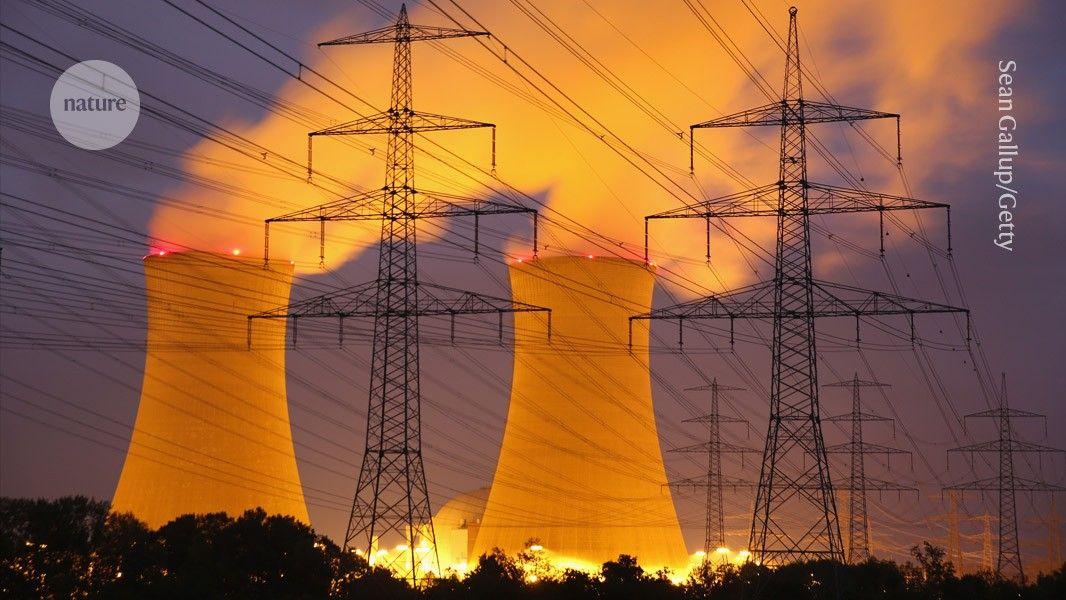US Climate Goals: Progress and Challenges in Emissions Reduction
3 Sources
3 Sources
[1]
We're at a make-or-break moment for US climate goals
Greenhouse gas emissions are falling in the US thanks to major investments in clean energy and transportation -- but it's not happening fast enough, a new report shows. As a result, the US isn't on track to meet the ambitious climate goals set by the Biden administration as the president enters his final months in office. Political upheaval and soaring electricity demand from AI, crypto, and EVs risk pushing those goals further out of reach.
[2]
Despite sizeable cuts to emissions, U.S. still far off track to hit its goals, report finds
Pollution spews from the Miami Fort Power Plant in Lawrenceburg, Ind., on May 31.Jason Whitman / AP The U.S. is making deep cuts in its greenhouse gas emissions as clean energy booms -- but not enough to hit the target it set under the Paris Climate Agreement, according to a new analysis from Rhodium, a research company that tracks U.S. progress toward its climate goals. Under the agreement, in which 194 countries pledged to limit global average rises in temperature to well below 2 degrees Celsius, the U.S. set a goal of reducing its emissions by at least 50% below 2005 levels by 2030. The Rhodium report projects U.S. greenhouse gas emissions will fall 32% to 43% below that threshold by 2030 and 38% to 56% five years later. The report suggests that clean energy investment is accelerating rapidly, that economic growth no longer depends on fossil fuels and that President Joe Biden's two climate initiatives -- the Inflation Reduction Act and the Infrastructure Investment and Jobs Act -- are helping push the pace of electrification. But there are headwinds, as well: Power-hogging data centers have begun to push electricity demand higher, the Supreme Court recently issued a ruling that undermined federal regulatory power, and Democrats and Republicans are pushing radically different climate agendas as the election looms. The U.S. set records last year for adding solar power and clean energy storage to the grid, the report says. Ben King, an associate director with the Rhodium Group's energy and climate practice, said history is likely to remember the past few years as an "inflection point" in climate policy. "This is where clean energy went mainstream," King said. "It's real business. It's not your hippie neighbor with solar panels on the roof." However, the energy transition remains far too slow to reach U.S. emissions goals without new policy measures. The report assumes the pace will quicken, but to hit the upper end of Rhodium's predictions for potential emissions reduction (43% by 2030), the rate of added clean energy capacity would need to increase several times over. King said the renewable energy industry faces barriers that need to be smoothed out to get new projects built and operating more quickly. "There have been some real challenges in the near term -- challenges with building transmission lines, plugging these facilities into the grid and just getting the stuff to install, especially for wind post-Covid," King said, adding that finding sites and securing permits remain problems, too. The need for new sources of electricity is urgent. The report authors estimate that electricity demand will be 24% to 29% higher in 2035 than in 2023 as more vehicles and appliances go electric and as energy-intensive data centers are used to run artificial intelligence systems, mine cryptocurrency and power cloud computing. The estimated increase in demand is much higher than Rhodium predicted just last year. Investment in clean energy, transportation and technology is growing rapidly. In the first quarter of 2024, firms invested $71 billion in the sector, a 40% increase from the same time in 2023. Clean energy now accounts for more than 5% of private investment in structures, equipment and durable consumer goods, according to the report. "It's cool to see private capital really flowing into the clean tech space and hopefully finding some winners, some technologies, that are really going to help move the needle," King said. Much of the U.S. greenhouse gas trajectory hinges on the November election, the Rhodium report says. Republicans could seek to dismantle parts of the Inflation Reduction Act if they win the White House and take control of Congress, King said. In June, Donald Trump's campaign told Politico he would pull the U.S. out of the Paris Agreement for a second time if he is elected. Rhodium also expects a wave of challenges to environmental policies following the Supreme Court's Chevron ruling, which newly limits federal agencies' power. The next administration will shape the defenses to those challenges.
[3]
AI boom to slow pace of U.S. emissions reduction, report says
(Bloomberg) -- U.S. greenhouse gas emissions are not falling fast enough to meet the Biden administration's goal of cutting greenhouse gas pollution by at least half in 2030, compared with 2005 levels, according to new analysis by research firm Rhodium Group. The group said the Inflation Reduction Act, passed in 2022, has helped create a pathway for deep decarbonization across the energy and transportation sectors - but the U.S. is still only on track to achieve as much as a 43 per cent emissions reduction at the start of the next decade. The report highlights skyrocketing electricity demand from artificial intelligence and other data center uses as one of the key obstacles. "This extra demand means emissions could have been lower by 2025," said Ben King, one of the lead authors of the report, in an interview. Rhodium's outlook for U.S. emissions comes just over a week after new figures indicated that China, the world's biggest polluter, may have peaked its output of greenhouse gases last year. A rapid pace of emissions reductions in China and the U.S., the second biggest emitter, would play a critical role in meeting the Paris Agreement's goal of limiting planetary warming to below 2C above the pre-industrial average, and ideally to 1.5C. As part of the U.S.'s commitment to the agreement, the Biden administration pledged the country will achieve net zero emissions no later than 2050. The U.S.'s current trajectory to 2030 and beyond suggests the country is off track for this mid-century goal, according to the report. "The U.S. knew it was setting an ambitious target with that agreement," King said, noting there has at least been progress in emissions reductions. For example, U.S. emissions fell 1.9 per cent year-over-year in 2023 even as the economy expanded. To give that more perspective, U.S. emissions last year were 18 per cent lower than they were in 2005. The passage of the IRA has also made further cuts look more likely as it supports the expansion of wind, solar and electric vehicles. Rhodium projects zero-emitting sources like wind, solar and nuclear could account for 62-88 per cent of total electricity generation in 2035, due to support from IRA subsidies and new Environmental Protection Agency limits for power plant emissions. It forecasts that power sector emissions reductions over 2023 to 2035 could range from 42 to 83 per cent depending on how quickly cleaner power generators can be built to match growing electricity demand from EVs and data centers. Transportation sector emissions could decrease by 22-34 per cent over the same period, aided by stringent EPA standards for vehicles. Rhodium sees EVs representing as much as 74 per cent of light-duty vehicle sales by 2032. Still, Rhodium notes its projections are based on current federal and state policies -- and a lot could change depending on the results of elections in November. The report said a win for former President Donald Trump might lead to policy rollbacks. King warned cuts to policies could reverse recent gains, complicating the decarbonization path.
Share
Share
Copy Link
A comprehensive look at the United States' efforts to reduce greenhouse gas emissions, the impact of AI on energy consumption, and the country's progress towards meeting Paris Agreement goals.

US Emissions Reduction Progress
The United States has made significant strides in reducing greenhouse gas emissions, but recent reports suggest that the country may fall short of its Paris Agreement commitments. According to a study by the Rhodium Group, US emissions are projected to decrease by 25% to 34% below 2005 levels by 2030
1
. While this represents progress, it falls short of President Biden's goal of a 50% reduction by the end of the decade.Impact of Clean Energy Initiatives
The Biden administration's clean energy policies, including the Inflation Reduction Act and the Infrastructure Investment and Jobs Act, have played a crucial role in driving down emissions. These initiatives have accelerated the adoption of renewable energy sources and promoted energy efficiency across various sectors. However, experts argue that additional measures may be necessary to bridge the gap between current projections and the Paris Agreement targets
2
.AI Boom and Energy Consumption
An unexpected factor influencing emissions reduction efforts is the rapid growth of artificial intelligence (AI). The AI boom has led to increased energy consumption in data centers and other computing infrastructure. A report by BNN Bloomberg suggests that this surge in AI-related energy use could potentially slow down the pace of US emissions reduction
3
. This highlights the need for sustainable practices in the tech industry to mitigate the environmental impact of AI advancements.Related Stories
Challenges in Meeting Paris Agreement Goals
Despite progress, the United States faces significant challenges in meeting its Paris Agreement commitments. The current trajectory suggests that without additional policy interventions or technological breakthroughs, the country may struggle to achieve its 2030 emissions reduction target. Factors such as economic growth, population increase, and the slow phase-out of fossil fuels continue to pose obstacles to more rapid decarbonization
2
.Future Outlook and Potential Solutions
To bridge the emissions gap, experts suggest a multi-faceted approach. This includes accelerating the transition to clean energy sources, improving energy efficiency across all sectors, and investing in carbon capture and storage technologies. Additionally, addressing the energy consumption of emerging technologies like AI will be crucial in balancing technological progress with environmental sustainability
1
3
.As the United States continues its efforts to reduce emissions, close monitoring and adaptive policies will be essential to stay on track with global climate goals. The interplay between technological advancements, economic factors, and environmental policies will shape the country's ability to meet its Paris Agreement commitments in the coming years.
References
Summarized by
Navi
[1]
Related Stories
Recent Highlights
1
Nvidia acquires AI chip startup Groq for $20 billion in largest deal ever
Technology

2
Chinese AI Models Close Gap With US Systems as Open-Source Strategy Reshapes Global Tech Order
Policy and Regulation

3
Samsung unveils Exynos 2600, world's first 2nm smartphone chip set to power Galaxy S26 series
Technology








